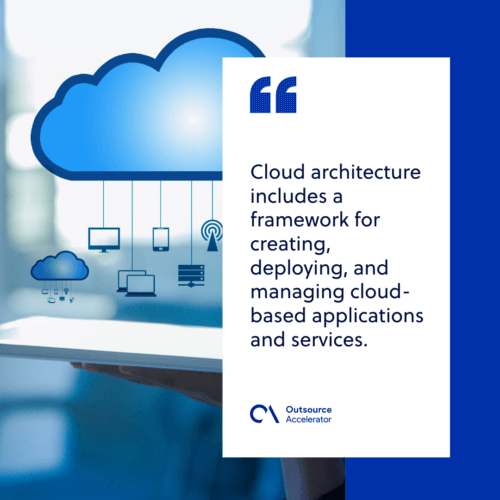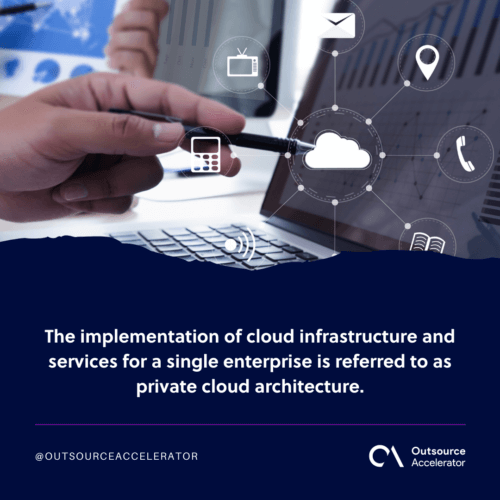Demystifying cloud architecture: A brief introduction

Cloud architecture is a critical element of cloud development. It links all relevant cloud computing components and technology.
Compared to on-premises settings, migrating to the cloud may provide several business benefits ranging from greater agility and scalability to cost savings.
While many businesses may begin with a lift-and-shift strategy, cloud architecture determines how various factors are connected. This allows resources to be pooled, shared, and scaled over a network.
Importance of cloud architecture
Cloud architecture has transformed how organizations function by delivering flexible and scalable solutions for various computing requirements.
It is critical in enabling enterprises to take advantage of the potential of cloud computing effectively. It also includes a framework for creating, deploying, and managing cloud-based applications and services.
Cloud design enables enterprises to scale their infrastructure up or down based on demand. This adaptability guarantees efficient resource allocation, eliminates over-provisioning, and reduces costs.
Cloud architecture is intended to deliver dependable and highly available services. It enables cloud services to deliver on a pay-as-you-go basis. This is where businesses can only pay for the resources they utilize, resulting in considerable cost savings.

3 layers of cloud architecture
Cloud architecture has three main layers, each serving a specific purpose in the cloud ecosystem.
Let’s explore these layers in detail:
1. Infrastructure layer
Cloud architecture is built on the infrastructure layer. It consists of physical components and virtualization technologies that allow for developing and controlling virtual machines (VMs) and other resources.
The infrastructure layer encompasses:
Physical infrastructure
This component contains server storage devices, network equipment, and data centers that serve as the cloud infrastructure’s backbone.
Virtualization and hypervisors
Hypervisors and other virtualization technologies enable the construction of virtual computers by abstracting physical hardware resources. It oversees the efficient allocation, separation, and administration of virtualized environments.
2. Platform layer
The platform layer, built on the cloud infrastructure layer, offers a runtime environment for applications and services.
It contains the middleware, operating systems, and programming frameworks required for application and software development.
The following are included in the platform layer:
Middleware and operating systems
Middleware acts as a bridge between the application layer and the underlying infrastructure. It provides services such as message queues, caching, and authentication—facilitating communication and integration between different components.
Development frameworks and tools
Development frameworks and tools simplify the process of building and deploying applications on the cloud platform.
These frameworks provide pre-built components and libraries, enabling developers to focus on application logic rather than cloud infrastructure concerns.
3. Application layer
The application layer represents the topmost layer of cloud architecture and encompasses the actual applications and services that run on the cloud platform.
The essential elements of the application layer include:
Cloud-native applications
Cloud-native apps are those that are particularly intended to make use of the benefits of cloud architecture and cloud computing.
This is created with cloud-native characteristics like scalability, elasticity, and resiliency. Cloud-native apps frequently use cutting-edge technologies such as:
- Containers
- Serverless computing tools
- Distributed architectures
Microservices and containerization
Microservices design divides applications into smaller, self-contained services that may be independently created, deployed, and scaled.
Containers provide optimal resource use and simpler cloud architecture management by providing lightweight and portable cloud solutions.
Cloud architecture deployment models
Cloud architecture deployment models refer to three ways companies can choose the most suitable approach for their cloud-specific needs.
Public cloud
This refers to a deployment paradigm in which enterprises use cloud services supplied by third-party suppliers over the internet. Businesses can use the vendor’s infrastructure, platforms, and applications on a shared basis with the public cloud.
However, it is crucial to recognize that the public cloud may have certain flexibility and data security constraints, particularly for specific use cases.
Because several clients share the infrastructure and resources, customization choices may be limited, and data privacy and compliance problems may arise.
Before deciding to use the public cloud, businesses must thoroughly assess their needs and regulatory duties.
Private cloud
The implementation of cloud infrastructure and services for a single enterprise is referred to as private cloud architecture.
It can be hosted locally on the company’s grounds or in a specialized data center. The private cloud offers more control, flexibility, and security than the public cloud.
One of its key advantages is the amount of control a private cloud provides. In other words, organizations have total control over the cloud’s infrastructure, apps, and data. It allows them to customize the environment to their needs.
This is especially useful for companies that deal with sensitive data or are subject to stringent regulatory regulations.

Hybrid cloud
The benefits of both public and private clouds are combined in hybrid cloud architecture. It enables businesses to take advantage of the scalability and cost-effectiveness of the public cloud.
Meanwhile, the hybrid cloud controls and manage sensitive data and essential workloads via the private cloud.
Workload mobility is another advantage of hybrid cloud computing. Workloads and data may be readily moved between public and private clouds, allowing seamless migration and resource allocation.
This agility enables firms to scale resources up or down in response to changing demands rather than being restricted to a single cloud architecture paradigm.
Cloud architecture in a nutshell
Understanding cloud architecture’s three distinct layers, including the infrastructure, platform, and application, is critical for creating and delivering efficient cloud-based solutions.
Furthermore, examining the different deployment options of the cloud architecture enable enterprises to select the best method depending on their requirements.







 Independent
Independent




